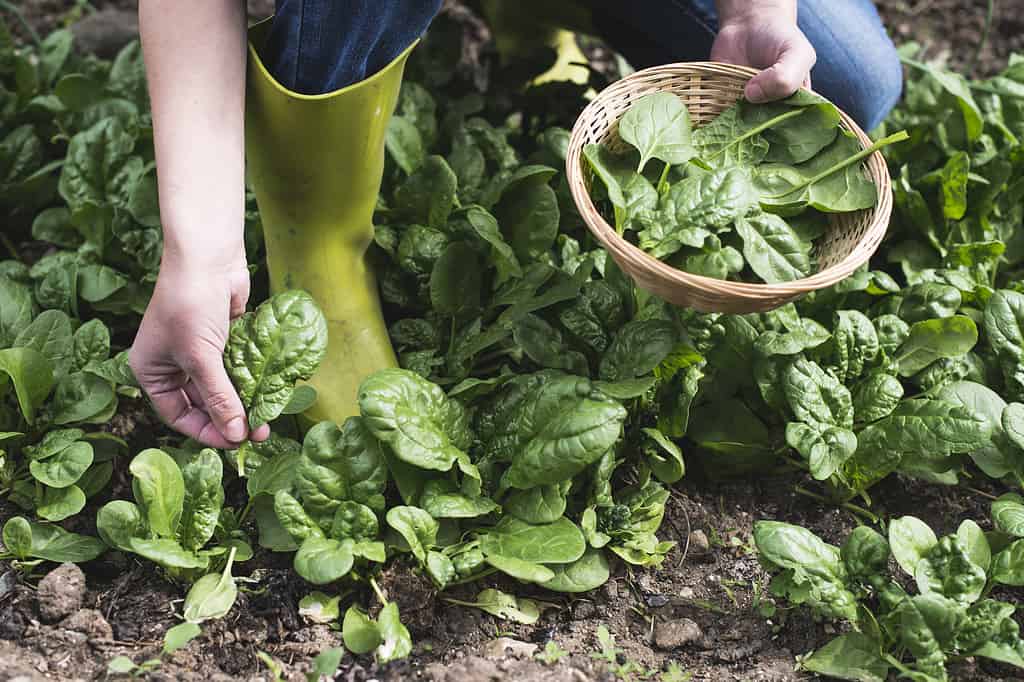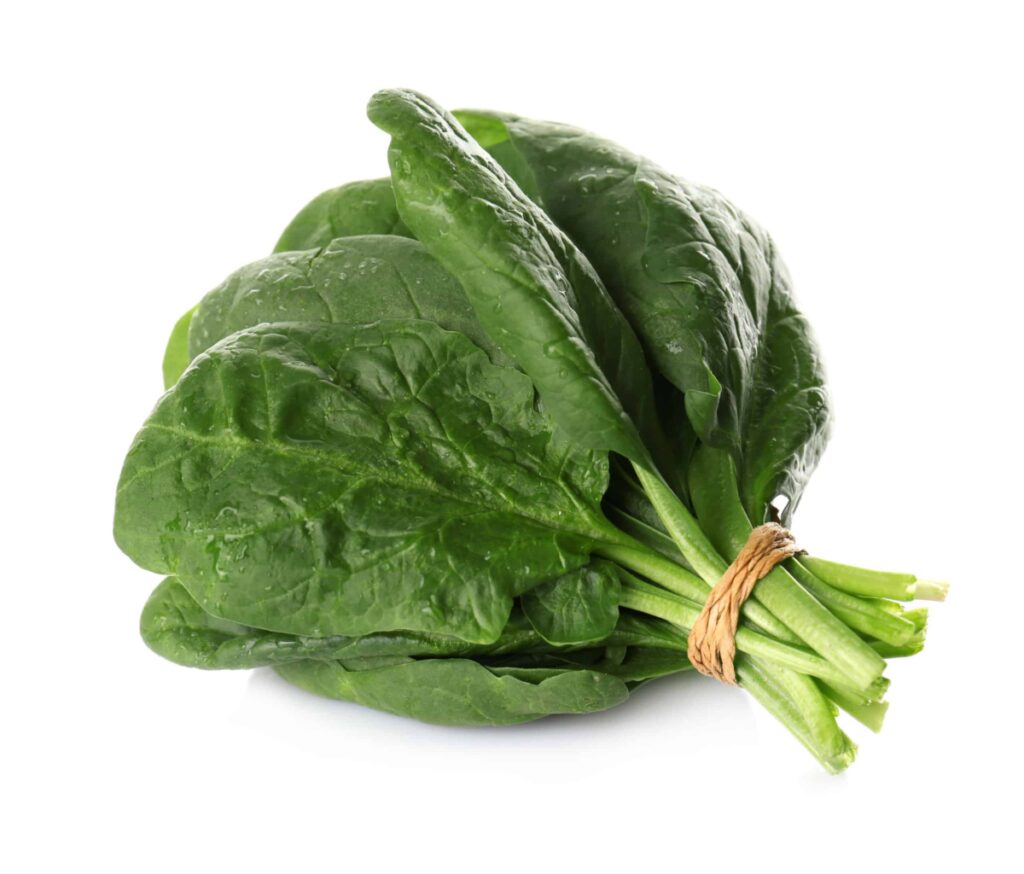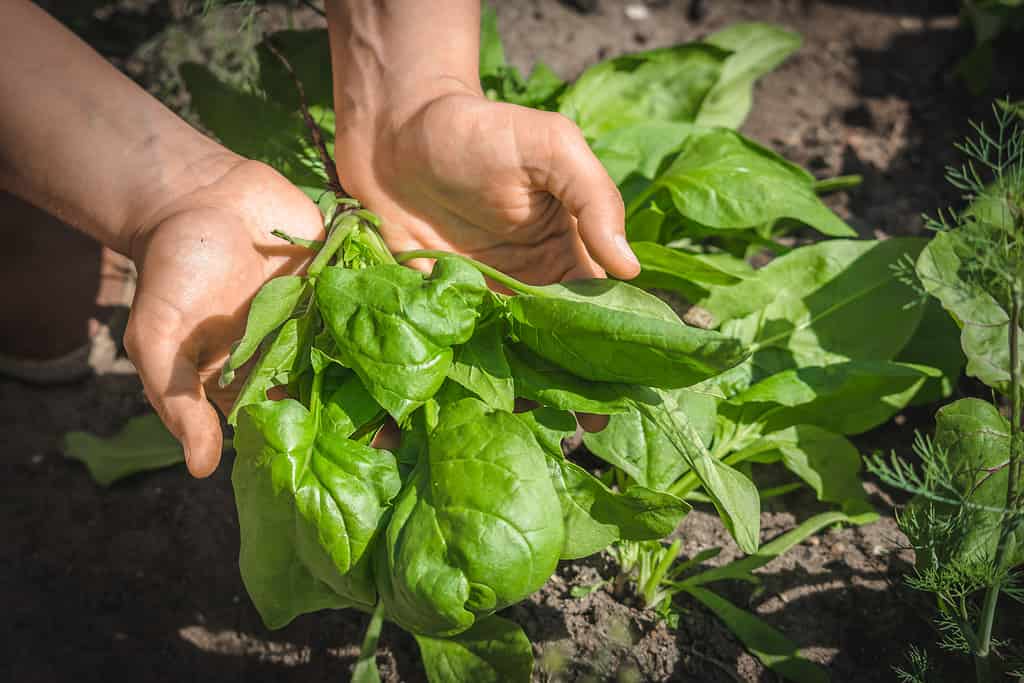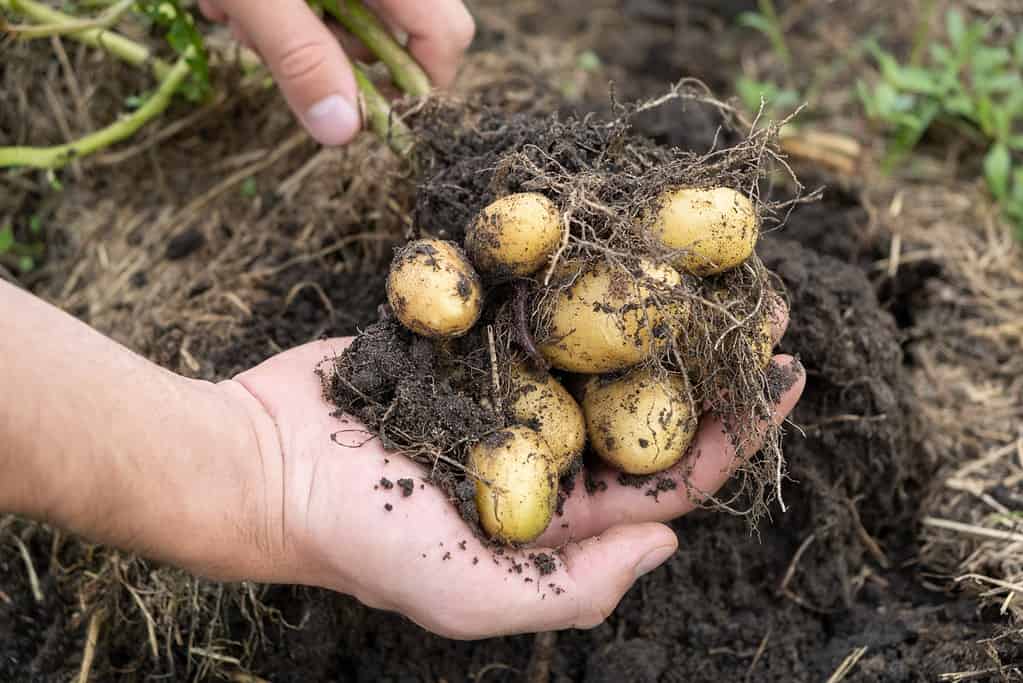Planting spinach is easy and rewarding. It is a cold-tolerant leafy green, making it an ideal vegetable to plant in the early spring. Spinach is also one of the few vegetables that can withstand colder temperatures. It can even thrive in the winter in some areas! Planting spinach will provide you with a nutritious harvest of delicious leaves throughout the growing season. Here is our complete guide to get you started!
About Spinach

Spinach thrives best when planted during the cooler months of spring or fall but can also tolerate light frosts.
©Deyan Georgiev/Shutterstock.com
Spinach is a cool-season vegetable that can be grown in many different climates. It’s easy to grow and requires minimal care, making it an ideal choice for beginner gardeners. Spinach thrives best when planted during the cooler months of spring or fall but can also tolerate light frosts.
In terms of nutrition, spinach is one of the most nutritious vegetables you can grow in your garden. It’s higher in iron than most other cultivated greens. This helps keep red blood cells healthy and prevents anemia from developing. It is also high in calcium which helps build strong teeth and bones. In addition, it has loads of vitamins A, B, and C, which are essential for maintaining healthy skin and eyesight. Unlike lettuce leaves that are only crunchy when eaten raw, spinach has both crunchy raw leaves and soft cooked leaves.
Where to Plant
When choosing a spot to plant your spinach, ensure it gets at least 6-8 hours of sunlight daily. It can tolerate full sun or light shade, but more shade will mean the plants won’t grow as large and may not yield as much. Before planting, prepare the soil by adding compost about a week before seeding. Dig the compost under to a depth of six inches. In areas with mild winters, you can also prepare the soil in late summer or early fall for an autumn harvest. Make sure to aerate and turn over the soil deeply to ensure good drainage and proper oxygenation for optimal growth of your spinach crop.
When to Plant

If you are aiming for a summer harvest, try New Zealand Spinach or Malabar Spinach instead.
©iStock.com/JackF
When planting spinach, it is best to sow the seeds directly into the soil as soon as it warms to 40°F. To speed up this process, gardeners can cover the soil with black plastic. Although some may opt to start their seeds indoors, this is not recommended, as seedlings are difficult to transplant.
Gardeners in colder climates should plan on planting just before the cold weather arrives in fall and then protect the young plants with a cold frame or thick mulch through winter until soil temperatures reach at least 40ºF in springtime. Once protected, remove the mulch layer when ready to harvest some of your spinach crops and then replace it once finished picking.
Common spinach is not able to survive a midsummer planting since the summer heat will be too intense. If you are aiming for a summer harvest, try New Zealand Spinach or Malabar Spinach instead. These two similar leafy greens are much more tolerant of higher temperatures and can easily tolerate hotter climates.
For a fall crop, it is best to re-sow in mid-August when the soil temperature does not exceed 70°F. Planting in cooler soil will allow your spinach plants to get off to a good start and ensure that they thrive throughout the growing season without being stressed by extremely hot weather.
How to Plant
To get the best possible results when planting spinach, seeds should be sowed 1/2 of an inch deep every 2 inches. Plant your rows 12 inches apart for optimal growth, or sprinkle over a wide row or bed if you prefer. To ensure a continuous harvest throughout the spring season, sow seeds every couple of weeks from early spring onwards. When choosing which type of seed to use, try opting for varieties that are suited to your local climate, as this will help maximize your yield.
How to Grow

Spinach is hardy down to 15°F, so don’t worry too much as fall weather cools.
©New Africa/Shutterstock.com
When you water your spinach, make sure to keep the soil constantly moist. This will ensure that your spinach grows healthy and strong. To maintain cool soil temperatures and deter pests, cover the rows of spinach with row covers or other suitable material. Once the seedlings sprout up to about 2 inches tall, thin them, so they are 3-4 inches apart. You can actually eat the thinning!
No further cultivation is necessary since their roots are shallow and easily damaged if disturbed too much. Be sure to water regularly and mulch around the base of plants in order to retain moisture levels in the soil.
When plants reach half of their full size, they may need a high-nitrogen fertilizer to ensure they have all the nutrients required for healthy growth. Nutrient deficiencies can be identified by yellow leaves, stunted growth, leaves dropping early, and other symptoms.
Spinach is hardy down to 15°F, so don’t worry too much as fall weather cools. Providing some frost protection may be wise if your seedlings are still very small.
When to Harvest
It is important not to wait too long after maturity before harvesting, as the leaves will quickly become bitter. This can be a particular problem in the summer months when there is increased daylight and warmer temperatures.
These conditions will likely cause spinach plants to bolt, which involves them growing a large stalk with a seedhead attached, resulting in an unpleasant taste. If bolting has already begun, it may still be possible to salvage some of the spinach- try pinching off any flower heads while keeping the soil moist and providing shade if possible. Alternatively, pull up the entire plant and use what leaves you can.
How to Harvest

It’s important not to wait too long when harvesting spinach—the larger they get, the more bitter they become.
©alicja neumiler/Shutterstock.com
When harvesting spinach, you should pick off or cut individual leaves every few weeks, starting with the outer leaves and working your way inward. This will also give the inner leaves time to mature before plucking them if desired.
If you’d prefer to harvest the whole plant at once, carefully cut it by the base. It’s important not to wait too long when harvesting spinach—the larger they get, the more bitter they become, so keep that in mind while picking. Spinach plants take six to eight weeks to grow, but their roots are easily damaged, so be sure to handle them gently during harvest.
How to Store
When storing fresh spinach, do not wash it until you are ready to use it. This will help preserve its quality for up to a week and stop too much moisture from hastening the spoilage of your spinach. After washing, pat dry with a paper towel and store in an airtight plastic container or bag along with the paper towel, which will help absorb any excess moisture.
If you plan on freezing your spinach, make sure to wash it beforehand and trim off the ends, as well as any yellowing leaves. Blanching is also recommended before packing into freezer bags for optimal shelf life. When thawed, it will be mushy, but it makes an excellent addition to soups, stews, or steamed greens.
Companion Plants
There are many good companions for spinach. It generally plays well with others. Some of the best companion plants are brassicas like cabbage, radish, cauliflower, Brussels sprouts, and broccoli. Other good choices are alliums, like garlic, leeks, and onions. You can also plant lettuce, nasturtiums, peas or strawberries with your spinach.
Cabbage and Radish – Spinach makes a great companion plant for cabbage and radish, as crop rotation helps to prevent pests from becoming too prevalent in one area. To help distract leaf miners, sow radish seeds in alternate rows of your spinach bed. Leaf miner damage to the tops of the radishes will not affect their root growth, so this method can be used without fear of compromising your harvest!
Alliums – Plants like garlic, leeks, and onions make great companions for spinach. These alliums are strongly scented and repel many types of insects. Beetle, carrot rust flies, and beetles, in particular, don’t like onion family plants. Alliums also produce flowers that attract nice bugs like lady beetles and parasitic wasps who will munch on the naughty bugs.
Cauliflower and Brussels sprouts – Brussels sprouts and cauliflower are great friends to spinach. They have a root system that grows in a different zone than spinach, so they don’t steal water or nutrients from each other. They also help shade the spinach from the hot sun as summer approaches, saving you from bolting a little while longer.
Lettuce – Spinach and lettuce are best pals. They grow at similar rates and sizes and mix together well. Both can be planted very close to each other, which helps keep the soil cool for longer. They also require the same nutrients and water, so gardening chores become easier.
Nasturtium – Is there any garden vegetable with which nasturtiums don’t pair well? This strong-smelling flower will attract aphids, so planting it at the edge of your spinach crop will keep them from snacking on your spinach.
Peas – Peas are a perfect bedfellow for nitrogen-hungry spinach. Peas fix nitrogen into the soil for the spinach to eat. This saves you from having to provide extra fertilizer. Peas also acts as a light shade screen for spinach as the days get hotter, preventing bolt.
Strawberries – Spinach and strawberries are a great companion plant combination. The perennial strawberries will return each year, and their ground-covering growth habit helps keep the soil cool, preventing the spinach from bolting in warm weather. Additionally, the deep roots of the strawberry plants prevent competition with the spinach for moisture and nutrients while occupying different spaces in the garden. The strawberries are generally quite short, while the spinach can reach up to 18 inches tall.
Bad Companions

Growing potatoes close to spinach is not a good idea.
©ArieStudio/Shutterstock.com
Fennel is not just spinach’s worst enemy; it is a bad companion for all food crops except dill. Fennel releases chemicals into the soil that can inhibit the growth and development of nearby plants, like spinach. These chemicals are released through both their roots and leaves, making them even more dangerous to other plants in your garden. If you choose to plant fennel near other food crops, ensure it is planted far away from those plants or risk stunted growth or worse!
Potatoes – Growing potatoes close to spinach is not a good idea. Potatoes are very demanding when it comes to nutrients, water, and space, so they can quickly consume all the resources from the soil and leave none for your spinach. Additionally, as the potatoes reach their fullest size and leafiness, they will cover and block out the sunlight from your late-season spinach crop.
Summary of How to Grow Spinach
| Growing Spinach | Spinach Recommendations |
|---|---|
| Sun | Full sun 6-8 hours of direct sun daily. Can tolerate partial shade. |
| Soil | Nutrient-rich and well-draining. pH 6.5-8.0 |
| When to Plant | Direct sow seeds when the soil temperature is 40°F or higher |
| Planting Measurements | Plant seeds 1/2 inch deep and 2 inches apart. Space rows 12 inches apart. |
| When to Harvest | 6-8 weeks. Harvest from outer leaves inward. |
| How to Store | Unwashed, dry, and wrapped in paper towels. In the fridge for 7-10 days. |
| Companion Plants | Cabbage, radish, cauliflower, Brussels sprouts, broccoli, garlic, leeks, onion, lettuce, nasturtiums, peas, or strawberries. |
The photo featured at the top of this post is © iStock.com/okugawa
Thank you for reading! Have some feedback for us? Contact the AZ Animals editorial team.






